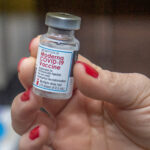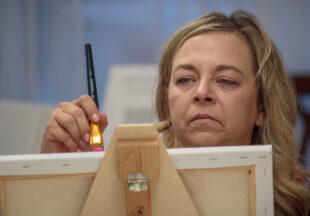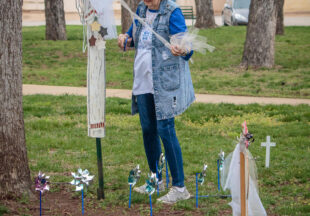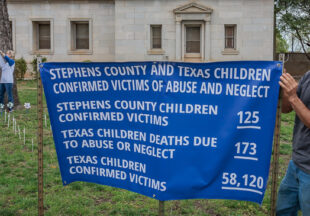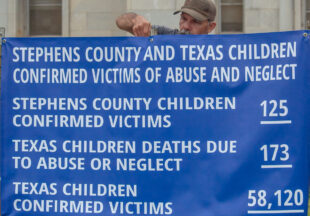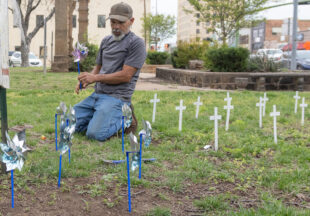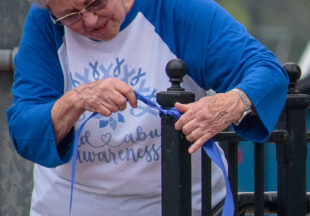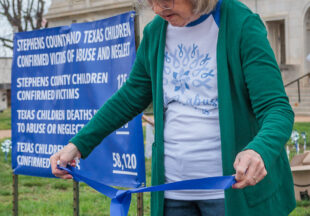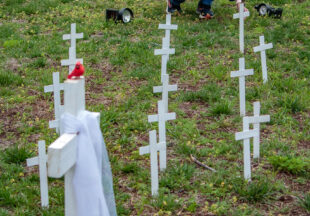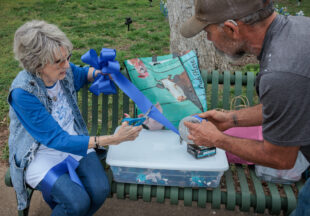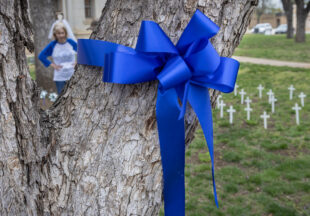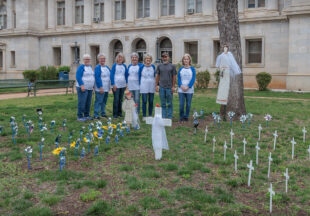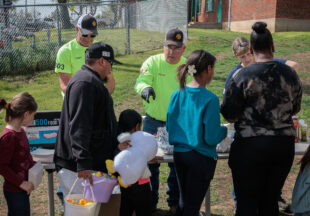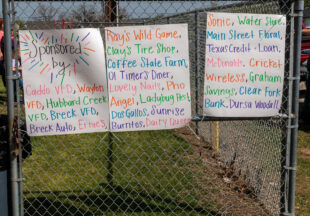COVID-19 continues to threaten area as first vaccines arrive in Stephens County
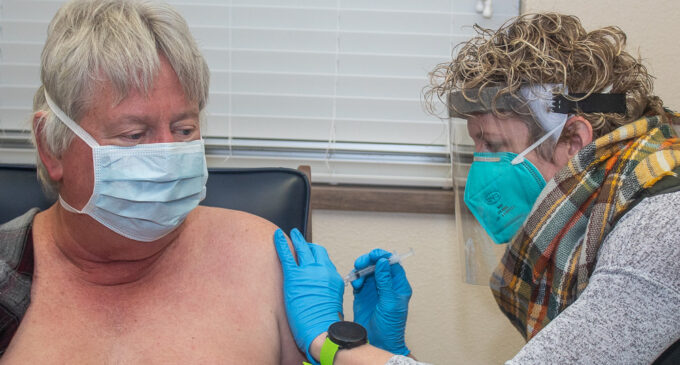
By Tony Pilkington/Breckenridge Texan
As we move into the new year, the COVID-19 case surge continues to have a major impact on Breckenridge and the surrounding area. However, last week there was a small positive development when 10 employees at Stephens Memorial Hospital received the first dose of the Moderna vaccine.
First Vaccines in Stephens County
Although nobody from Stephens County was on the initial list of people to receive the vaccine last week, Pharmacist Julie Glueck Honea with Brookshire’s Pharmacy in Cisco and who also works for Hunter Pharmaceutical that takes care of the Stephens Memorial Hospital pharmacy, was able to bring 10 doses of the vaccine to give to the local staff.
She said by Thursday she had already given vaccines shots in Eastland, Rising Star, and at the Brookshire’s store in Cisco. They are currently focusing on health care workers in those areas, and the 10 doses she brought with her on Thursday were the last 10 doses she had. Those SMH employees will get the second dose of the vaccine in a month.
“People are excited to get it,” Honea said. “And we still have a huge waiting list. We’ve started the list for the 65-and-older population. We have a huge list. And just as soon as we can get some more, you know, we want to get that out to them.”
One of the Breckenridge medical staff who received the first shots of the vaccine was Dr. William Prater. He said it was good to start getting people vaccinated but that the community and staff still need to continue to take preventive measures to prevent the spread of the virus.
“We’ve still got to wear masks, wash hands, and do social distancing and all that good stuff until we get herd immunity,” he said. “Having this shot, it’ll be a month before I have the neutralizing antibodies to protect me 90-something percent. We don’t have wide-scale availability. It’ll be better when you (can) walk into CVS or Walmart and get your vaccine or into the clinic and get your vaccine.”
As of Thursday, local officials still had not been advised of when additional doses of the vaccine for the community will arrive.
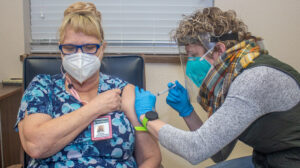
Karen Guynes receives a dose of the COVID-19 vaccine from Julie Glueck Honea at Stephens Memorial Hospital on Thursday, Dec. 31. Ten local health professionals received the first dose of the vaccine and will receive their second dose in about a month. (Photo by Tony Pilkington/Breckenridge Texan)
Ongoing COVID-19 treatment
Although a vaccine that will prevent the virus is a good thing, Dr. Prater said there it is still a lot of difficulty trying to treat patients who have already contracted the virus. On Thursday, Dec. 31, SMH reported 56 active cases of COVID-19 in Stephens County.
“Well, we’ve learned a lot about what doesn’t work. You know, the death rates are pretty high,” he said. “And it’s frustrating because we don’t have anything that truly cures you of it. That’s for sure.”
However, Dr. Prater said, he feels people are taking the virus much more seriously now than when it first came about last year. “When it first started up, it was a hard thing to sell,” he said. “I don’t think you’re still hearing people saying it’s a hoax.”
Another SMH healthcare worker who received the vaccine was LVN Karen Guynes, practice administrator at SMH. She said she was apprehensive at first about getting the vaccine but was glad that she was able to get it.
She said day-to-day life at the hospital is completely different since the pandemic started. Lots of people are calling with symptoms and being tested for COVID-19 while the clinic is also seeing patients with flu at the same time.
“Nobody’s comes into the clinic; they don’t walk in and sit in the waiting area,” she said. “They call from their phones in the car. And we go outside and swab them and go back in if they’re sick. And then that goes on to a phone visit to the providers. If they’re there to see the doctor, it’s the same. We do a screening call and then bring them in.”
Much has changed about the way the clinic staff works. “We bleach every room after a patient leaves, and everybody wears PPE (personal protective equipment),” Guynes said. “Used to, you just walked out to the lobby and just called them back. Now you’ve got to put your PPE on, get your swab test if you’re going to swab them. It’s a whole different world.”
COVID Hall
Another change at the hospital is the addition of a COVID Hall with six rooms dedicated to treating COVID-19 patients. The hallway has a plastic curtain covering the entrance to isolate the rooms from the rest of the hospital. In order for a hospital staff member to enter one of the rooms, Dr. Prater said, they have to “garb up” with a mask, gloves and disposable gown. On Thursday, there was one patient in the COVID Hall.
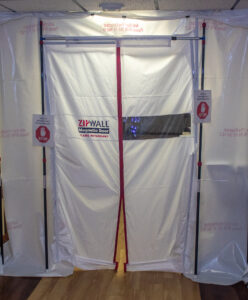
Stephens Memorial Hospital’s COVID Hall is blocked off with a plastic curtain. Anyone who enters must wear protective gear. (Photo by Tony Pilkington/Breckenridge Texan)
Dr. Prater said patients can be treated locally in the wing without being transferred to an ICU unit at a larger hospital as long as they have pretty good oxygen saturations and are not very low on oxygen in their body.
“If they’re sick, but not all that sick, we keep those here, usually,” he said. “But the ones that are having issues with blood pressure being real low or oxygen levels are being real low, they’re requiring lots and lots of oxygen, those people need to be taken to an ICU. I mean, all this is, basically, is a medical ward with infectious disease type precautions. It’s not an ICU; we’re not doing drips, dopamine drips and ventilators.”
Dr. Prater said he’s never seen anything like the COVID-19 pandemic since he’s been practicing medicine. “Nobody has,” he said. “This goes back to the days of smallpox, probably. Smallpox was a horrible disease. Smallpox was a pretty big killing kind of disease. And this kind of goes back to those days.”
He said with young healthy people, COVID-19 is typically no big deal to them because they get over it. “But, gray-haired people have a problem with it,” he said. “Or not at all. You may have somebody 70 years old with a lung transplant that survives it and a 40-year-old healthy working guy that dies of it. It just makes no sense. That’s how this thing operates.”
Hospital Capacity shortage
Another big problem being created by the recent surge of COVID-19 cases is a shortage of hospital capacity in the area. Chris Curtis, director of new business development for SMH, said they are still struggling to find ICU rooms to transfer patients to when they need a higher level of care. As of Sunday night, Hendrick Medical Center in Abilene reported that the percentage of COVID-19 hospitalizations out of total hospital capacity was 21.36 percent. They also had no ICU beds available.
As long as the capacity stays over 15 percent, the Governor’s GA-32 executive order remains in force in Trauma Service Area, which includes Stephens County. The area’s percentage of COVID-19 hospitalizations has to dip below 15 percent and stay lower for seven consecutive days before the restrictions are limited.
Also, Hendrick Health has 100 employees quarantined, according to a post on the hospital system’s Facebook page.
However, Curtis said, there is a bit of good news on that front. The State of Texas has granted a request by Rolling Plains Memorial Hospital in Sweetwater, allowing them to add more staff and have more beds available for COVID-19 and medical/surgery patients.
“So we’ll have that option,” he said. “Sweetwater’s further, but it’s not Harlingen (where SMH had to transfer one patient) or Big Spring, so it’s still a struggle. But hopefully, if we’re able to get people to Sweetwater, that would at least be a little closer to home.”
Stephens County Judge Michael Roach said that on a post on the county’s Facebook page, a nurse said that they spent 30 hours calling various hospitals before they finally found the bed for a patient who needed to be transferred.
“That’s the reality,” he said. “And I also saw this morning, where a man had a heart attack and he’s stuck at a local hospital but he can’t get high-level care because it’s taken up. So those are the other things people don’t realize; it’s not just about COVID hospital capacity. You have a stroke or heart attack, it affects that.”
Disruptions continue
The effects of the coronavirus pandemic also continue to disrupt local business and government operations. For example, on Wednesday, an employee in the Stephens County Tax Office tested positive for COVID-19, forcing the closure of the office until this week.
Roach said out of the abundance of caution, the county closed the office down until Monday. He said there are three staff members in that office and one tested positive on Wednesday, another has already recovered from COVID-19, and the third employee was sent home to quarantine to make sure they don’t have any symptoms.
“We didn’t want anybody from the community being exposed from coming up there, especially when it’s high volume tax season, and a lot of people come in on that last day of the year. So that was abundance of caution,” Roach said.
The deadline for taxes will be extended until Tuesday, Jan. 5, according to a notice on the county’s Facebook page.
Reporting the Numbers
One of the biggest challenges since the first case of the COVID-19 was diagnosed in Stephens County has been tracking the number of cases and the number of COVID-19-related deaths in the county.
Two sets of numbers that have been especially controversial are the number of people in Stephens County who have died from COVID-19-related causes and the number of cases at the Walker Sayle Prison Unit north of town.
Curtis, who is responsible for tracking and reporting the numbers, said it can sometimes be tricky, especially with tracking the number of deaths. He said that number can be a hard one to nail down because of the way the information has been reported.
“I have a lot of confidence in my positives (positive test results) and things like that, but the deaths…unless they occur here in the hospital, we really don’t have any way to track them,” he said. “And, we don’t know what’s going to be on the death certificate. So, we’re kind of dependent on the State and those guys to give us that information. I wish there was a way for us to have more control over that. But unfortunately, like I said, unless they pass away here in the hospital, we don’t really have a way to know.”
Last week, SMH reported that there have been a total of nine COVID-19-related deaths, which is lower than what the State of Texas is showing. Curtis said SMH’s numbers show patients who were in the hospital at SMH and who died while they were in the hospital. They also include ones that were added when they were reported to the hospital from the State. He said some of the people on the State’s list may not have actually been living in Stephens County at the time of their death.
For example, he said, SMH is reporting two deaths on their Facebook page of people who were living in assisted living centers in the in the DFW Metroplex when they died but who still had a Stephens County address. So, their deaths were counted toward the Stephens County’s number of deaths by SMH.
“Technically they were Stephens County residents, even though they hadn’t been here for years,” Curtis said.
The numbers at Walker Sayle Unit
As for the discrepancies between the number of cases at the Walker Sayle Unit being reported on the SMH Facebook page versus the TDJC website, Curtis said he is very confident in SMH’s numbers. He said the nurses who work at the prison and report the numbers are actually employees of SMH.
SMH employees, not prison employees, test the inmates for COVID-19, so the hospital and Curtis have direct knowledge of the number of inmates who have the disease.
He said the hospital employees know what the actual numbers are in real time. The discrepancy comes from the lag time between when the hospital gets the information about inmates who have tested positive and when that information gets posted online by the prison system.
“And so for some reason, (some people) think, those numbers on those websites are so accurate. In reality, like right now, the Department of State Health Services has Stephens County with three active cases. Well, we have 50-something,” Curtis said.
In another example, Curtis said as of Wednesday, when he was interviewed for this article, the SMH numbers showed the last time an active positive case at the prison was moved to the recovered list was on December 3. However, he said, according to the TDCJ website, it was only done in just the prior week.
“And so, my numbers are actual, the date they were tested.” he said. “Judge Roach and I were talking about it the other day. I said the IRS could come in and audit my numbers, and…I can justify them because I have a patient ID number, the date they were tested and the date they come off and all of that.”
Curtis said he knows there are some people in the community who think that the officials are “cooking up” the numbers, but he said it just takes a long time for the information to cycle through all the different databases and websites.
“So, again, I have the absolute up to date numbers as possible,” Curtis said, regarding the prison information.
Changes in death reports
Roach said the when the pandemic started and up until midway through the reporting process, all of the death numbers reported for Stephens County were coming from the Texas Department of Health Services, as reported by the counties.
However, he said what the state eventually recognized was that those numbers were not being recorded in an accurate way and the best way to report those numbers were through the State’s vital statistics department, which actually records all of the death certificates.
“So, then those numbers started coming from the Vital Statistics, but as a county elected official, I cannot get Vital Statistics’ numbers,” he said. “The only person that can get those is either the health authority for the city or for the county.”
Dr. Prater serves as the Stephens County Health Authority, and Dr. Kelli Windsor serves as the Health Authority for the City of Breckenridge. In order for them to get access to the numbers, Roach said, there has to be a memorandum of understanding with the Texas Department of Health’s Vital Statistics Department. They have already filed for that and are waiting for access to the system.
“It’s just like what happened early on,” Roach said. “Some of those numbers may have come from people who have homesteads in Breckenridge, but weren’t in our local hospital, weren’t being treated by our local doctors, (and) did not contract, nor succumb to COVID-19 locally. And there’s no way to know that unless you are being able to look at that system, which we’re fixing that. So we’re relying on the State numbers right now. And we do not know exactly who all passed away; we cannot see that information. We’ll be able to very soon, but we don’t have that at our fingertips.”
So for now, he said, the list of local deaths that hospital publishes only includes the numbers that they can verify, and as soon as they get access to that system, they will be able to verify the additional numbers from the state and add them to the totals.
“There are about five deaths out there, or six, that we’re not aware of those individuals’ names or any information,” he said. “So, as soon as we verify that, our numbers (of COVID-19 deaths) will go up. The State’s will probably end up being 14 or 15 before our does. But that’s just what it is.”
Roach said in order to help clear up some of the confusion, local officials are going to produce a report probably sometime in January that compiles all the data, like the people’s ages, comorbidities, and underlying health conditions that may have contributed to their death. However, he said, the report will not include people’s names for HIPAA reasons.
Striking a balance
Another challenge Roach said local officials have is striking a balance between providing people with important information and causing unnecessary fear.
“We don’t want to have an unhealthy fear,” he said. “And I’ve said this on our Facebook page a lot, and on some of our videos, that we don’t want to have an unhealthy fear with people living in anxiety. So we’re not just trying to sell fear all the time, but I can tell you that going around in our community, I don’t see there being a paralyzation of fear on the average. If there’s anything, there’s probably way, way too much caution thrown to the wind when it comes to dealing with the pandemic.”
However, he said, he understands people’s concerns. But also he knows that what local officials say and don’t say can have consequences both ways. He said if they are flippant and don’t pass along vital information, people could not be informed like they should be and people could die.
“So, if we don’t do the right thing and do our best to have Dr. Windsor and Dr. Prater share their thoughts, it becomes a risk to our community,” he said.
On the other hand, he said, if they overstate the big issues, which he said he’s not sure is possible during a pandemic, it could have an effect on local businesses. He said, for example, after they raised the latest threat level because of increased hospitalizations, there were businesses here in Breckenridge that saw big decreases in holiday party bookings. Some of businesses, he said, ended up with only two for the whole year when normally they’d have three or four every week.
“And, it’s because we said ‘Listen, here’s the deal, the threat levels are up, hospitalizations are limited,’” Roach said. “And it costs them business, because people said, ‘Based on the information, we don’t think it’s a wise thing to congregate,’ and they (restaurants) lost business, significant business, thousands of dollars.
“Now, I think it was the right thing to do for a business,” he continued. “I think it was the prudent thing to do, to not get all their employees and their extended families all together, 100 people crammed up in a party room. That’s not wise. But I’m just emphasizing that what we say does have an impact. So we’re just trying to make the point that we tried to exercise that responsibly and not try to be alarmist but be real with the data represented. And if that data does not fit a narrative, I’m sorry, I’m not into trying to craft the narrative. I’m trying to be as faithful to the facts as we can be, and make the public aware, which is it’s my job to do.”
Cutline, top photo: Breckenridge’s Dr. William Prater receives a dose of the Moderna COVID-19 Vaccine on Thursday, Dec. 31, from Pharmacist Julie Glueck Honea with Brookshire’s Pharmacy in Cisco. He and the nine others who received the vaccine will get the second dose in about a month. (Photo by Tony Pilkington/Breckenridge Texan)
Make sure you don’t miss any of the Breckenridge Texan’s news…click here to sign up for our email newsletter, the Weekly News Roundup. It has links to stories, photo galleries and more! It’s free to sign up, and it comes to you every Monday morning.



